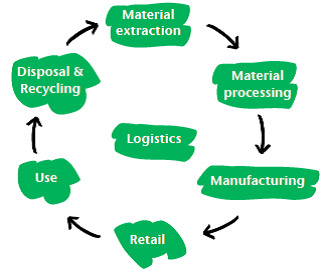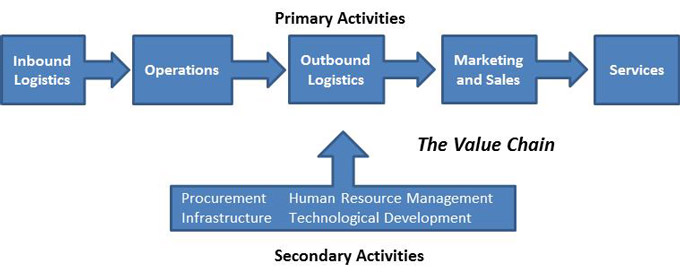'Value chain' versus 'supply chain'
| A ‘supply chain’ refers to the system and resources required to move a product or service from supplier to customer. The ‘value chain’ concept builds on this to also consider the manner in which value is added along the chain, both to the product / service and the actors involved. From a sustainability perspective, ‘value chain’ has more appeal, since it explicitly references internal and external stakeholders in the value-creation process. |
It also encourages a full-lifecycle perspective and not just a focus on the (upstream) procurement of inputs. Value is generally used in a narrow economic sense, but it can be interpreted to encompass ‘values’, ie ethical and moral concerns as well as other non-monetary utility values such as closing material loops, the provision of ecosystem services and added customer value. |
Want to learn more?
Accredited by University of Cambridge, the part-time Postgraduate Certificate in Sustainable Business: Value Chains stream helps professionals embed resilience into their organisation’s supply chains and the markets in which they operate by creating value across the full life cycle of a product. Find out more.
World Business Council for Sustainable Development (WBCSD)

"Value chains are an integral part of strategic planning for many businesses today. A value chain refers to the full lifecycle of a product or process, including material sourcing, production, consumption and disposal/recycling processes.”
Source: WBCSD (2011) Collaboration, innovation, transformation: Ideas and inspiration to accelerate sustainable growth – A value chain approach, p.3 & 5, emphasis added.
International Development Research Centre
“The value chain describes the full range of activities which are required to bring a product or service from conception, through the different phases of production (involving a combination of physical transformation and the input of various producer services), delivery to final consumers, and final disposal after use. Considered in its general form, it takes the shape as described in Figure 1. As can be seen from this, production per se is only one of a number of value-added links. Moreover, there are ranges of activities within each link of the chain. […] In the real world, of course, value chains are much more complex than this. For one thing, there tend to be many more links in the chain. […] In addition to the manifold links in a value chain, typically intermediary producers in a particular value chain may feed into a number of different value chains.”

Source: Kaplinsky, R. and M. Morris (2001), A Handbook for Value Chain Research, prepared for the International Development Research Centre (IDRC), p.4–6 (emphasis added).
SustainAbility, UNEP and UN Global Compact
“Supply chains and value chains have clear definitions in business literature and operational thinking. Where a supply chain typically refers to the chain of suppliers inputting to a final product, value chain also encompasses thinking about the value created by the chain, particularly for end-use customers. In reflecting on how sustainability is incorporated into conventional supply chains, [we need] to consider the wider context of the value of that activity – to the suppliers themselves, but also to the end-use customer and a range of other stakeholders, including communities and governments. This […] sits in the overlapping zone between supply chain and value chain – it draws from both concepts and hopefully also adds new dimensions that draw them closer together.”
Source: SustainAbility, UNEP and UNGC (2008), Unchaining Value: Innovative approaches to sustainable supply, p.2 (emphasis added).
Greenhouse Gas Protocol
“[…] ‘value chain’ refers to all of the upstream and downstream activities associated with the operations of the reporting company, including the use of sold products by consumers and the end-of-life treatment of sold products after consumer use.”
Source: GHG Protocol (2011) Corporate Value Chain (Scope 3) Accounting and Reporting Standard – Supplement to the GHG Protocol Corporate Accounting and Reporting Standard, World Resources Institute (WRI) and WBCSD, p.141 (emphasis added).
Porter's Value Chain – the seminal ‘business school definition’
“The idea of the value chain is based on the process view of organisations, the idea of seeing a manufacturing (or service) organisation as a system, made up of subsystems each with inputs, transformation processes and outputs. Inputs, transformation processes, and outputs involve the acquisition and consumption of resources - money, labour, materials, equipment, buildings, land, administration and management. How value chain activities are carried out determines costs and affects profits. Most organisations engage in hundreds, even thousands, of activities in the process of converting inputs to outputs. [According to Porter (1985) these] activities can be classified generally as either primary or support activities that all businesses must undertake in some form.”

Source: http://www.ifm.eng.cam.ac.uk/research/dstools/value-chain-/ drawing on Porter, Michael E., "Competitive Advantage". 1985, pp 11–15. The Free Press, New York.
Institute for Development Studies, University of Nairobi and University of Sussex
“The concept of the global value chain recognises that the design, production and marketing of many products now involves a chain of activities divided among enterprises located in different places. The value chain describes the activities required to bring a product from its conception to the final consumer. […] Figure 1.1 offers a stylised view of a typical chain. The chain includes all of a product’s stages of development, from its design, to its sourced raw materials and intermediate inputs, its marketing, its distribution, and its support to the final consumer.

The value chain concept has several dimensions. The first is its flow, also called its input-output structure. In this sense, a chain is a set of products and services linked together in a sequence of value-adding economic activities. […] A value chain has another, less visible structure. This is made up of the flow of knowledge and expertise necessary for the physical input-output structure to function. The flow of knowledge generally parallels the material flows, but its intensity may differ. […] The second dimension of a value chain has to do with its geographic spread. Some chains are truly global, with activities taking place in many countries on different continents. Others are more limited, involving only a few locations in different parts of the world. The third dimension of the value chain is the control that different actors can exert over the activities making up the chain. The actors in a chain directly control their own activities and are directly or indirectly controlled by other actors. […] Since value chains are basically constellations of human interaction, the possible varieties of governance are endless."








